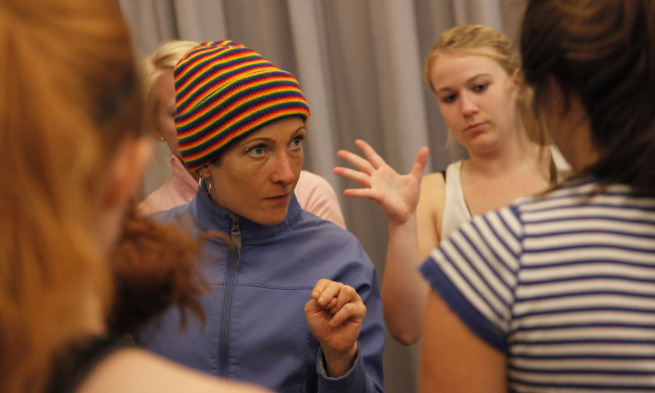When science and dance combine
Being the Change
Choreographers from the Liz Lerman Dance Exchange worked with JMU students on a dance that interprets the complex process of pulling energy out of food
By Brad Jenkins ('99)
Editor's note: In a speech regarding leadership in science, National Science Foundation Director Arden L. Bement Jr. commented, "I am often asked: "What keeps you awake at night?" My answer is: "The nation's continuing ability to compete in the global market." Scientific discovery, so crucial in today's competitive global market, increasingly requires individuals from different disciplines and perspectives to work together. It's the only way to solve the extraordinarily complex scientific challenges of our world. And, it calls for new approaches to education that will inform and inspire the next generation of innovators and explorers.
JMU is responding to the call. The 2010 freshman class participated in a yearlong series of integrated arts and sciences events focusing on the study of the genome. It started in August with Orientation: first-year students were introduced to JMU's academic culture using The DNA Age as a tool. Then, 4,000 freshmen became DNA in a mass dance on the Quad choreographed by the Liz Lerman Dance Exchange. In November, the Liz Lerman Dance Exchange was back on campus. This time a choreographic residency allowed them to share their nationally recognized talents with JMU freshman dance majors.
Torsos spin. Feet leap. Hips twirl. Bodies roll across the hardwood floor. Fifteen freshmen dance students are warming up for an intense rehearsal. Moments later, when the choreographer starts talking about the electron cycle, proton gradients and the Krebs cycle, you start wondering whether you're in a dance class or a science seminar.
Turns out, it's both.
The freshmen in the School of Theatre and Dance's Associate Dance Ensemble used their bodies to interpret the complex process known as cellular respiration, the process by which the body's cells harvest energy from food.
The dance was part of an Artist in Residence program with the Liz Lerman Dance Exchange from Washington, D.C., and part of a yearlong focus that is bringing together the arts and science.
"Not all of the protons move at the same speed, so not everyone has to move so fast" — it's instruction you don't expect to hear from the choreographer at a dance rehearsal. Nonetheless, students found dance gave them fresh perspective on the intricacies of science.
"It's incredibly complex, and our piece is complex," says dancer Carolyn Hoehner. "There's so much going on on stage. It makes you realize how much is going on in our bodies. I understand it a whole lot better. It makes so much more sense."
For her and others who participated in the residency, that's proof that seemingly disparate disciplines can coexist and thrive.
"There's more similarity than we would give ourselves credit for," says choreographer Elizabeth Johnson, one of two Lerman choreographers here for the residency. Both the similarities and the differences, she adds, creates a "spark that can ignite something new."
For these freshmen, that "something new" is an emphasis on cross-disciplinary studies and activities that will shape their Madison experiences.
Brittany Hoehlein sees it as a confirmation of why she came to JMU. Hoehlein applied to 17 schools, but many discouraged her from double-majoring in dance and kinesiology and instead focusing only on dance. JMU was different.
"Here, they said to use the two to complete each other," she says.
So Hoehlein, only three months into her JMU years, has already seen the interplay between her two majors. "Nothing," she says, "can exist on its own."
Later in the semester, the Liz Lerman Dance Exchange returned to the JMU campus for another residency and performances of "Ferocious Beauty: Genome" in the Forbes Center for the Performing Arts.
